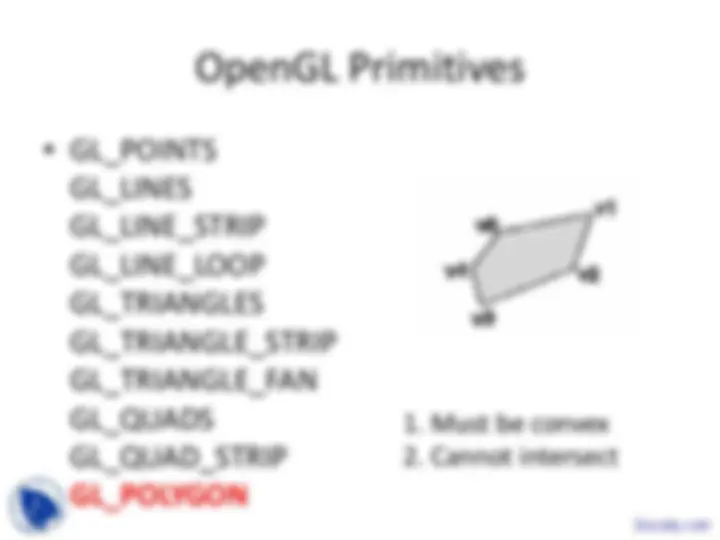















































Study with the several resources on Docsity

Earn points by helping other students or get them with a premium plan


Prepare for your exams
Study with the several resources on Docsity

Earn points to download
Earn points by helping other students or get them with a premium plan
Community
Ask the community for help and clear up your study doubts
Discover the best universities in your country according to Docsity users
Free resources
Download our free guides on studying techniques, anxiety management strategies, and thesis advice from Docsity tutors
In Introduction to Computer Graphics course we study the basic concept of the principle of computer architecture. In these lecture slides the key points are:Conceptual Graphics Framework, Graphics Library, Graphics Card, Immediate-Mode Fixed-Function Mode, State Machine, State Variables, Pseudo Code, Color and Shape, Pros and Cons, Bundles and Unsets, Local Variables
Typology: Slides
1 / 53

This page cannot be seen from the preview
Don't miss anything!














































OpenGL 2 (Fixed-Function)
Graphics System/ GPU Application Model/data base
Software Hardware
SetState (LineStyle, DASHED);
SetState (LineColor, RED);
DrawLine ( PtStart = (x1,y1), PtEnd = (x2,y2) );
SetState (LineColor, BLUE);
DrawLine ( PtStart = (x2,y2), PtEnd = (x3,y3) );
SetState (LineStyle, SOLID);
DrawLine ( PtStart = (x3,y3), PtEnd = (x4,y4) );
SetState (LineStyle, DASHED);
SetState (LineColor, RED);
DrawLine ( PtStart = (x1,y1), PtEnd = (x2,y2) );
SetState (LineStyle, DASHED);
SetState (LineColor, BLUE);
DrawLine ( PtStart = (x2,y2), PtEnd = (x3,y3) );
SetState (LineStyle, SOLID);
SetState (LineColor, BLUE);
DrawLine ( PtStart = (x3,y3), PtEnd = (x4,y4) );
function DrawTriangle (pt1,pt2,p3,
int origColor, int curColor,
int origStyle, int curStyle ) {
SetState( LineStyle, curStyle );
SetState(LineColor, curColor);
DrawLine( PtStart=pt1, PtStart=p2 );
DrawLine( PtStart=pt2, PtStart=p3 );
DrawLine( PtStart=pt3, PtStart=p1 );
SetState( LineStyle, origStyle );
SetState(LineColor, origColor);
}
DrawLine ( PtStart = (x1,y1), PtEnd = (x2,y2) );
SetState(LineStyle, 12345); DrawLine( PtStart=pt1, PtStart=p2 );
void setChild (CWidget* child)
{
myChild = child; child->setParent(this);
}
MyMouse* getMouse() {
return myMouse;
}
void setParent (PWidget* parent) { myParent = parent; }
void doStuff () { MyMouse mouse = myParent->getMouse(); doStuffWithMouse (mouse); }